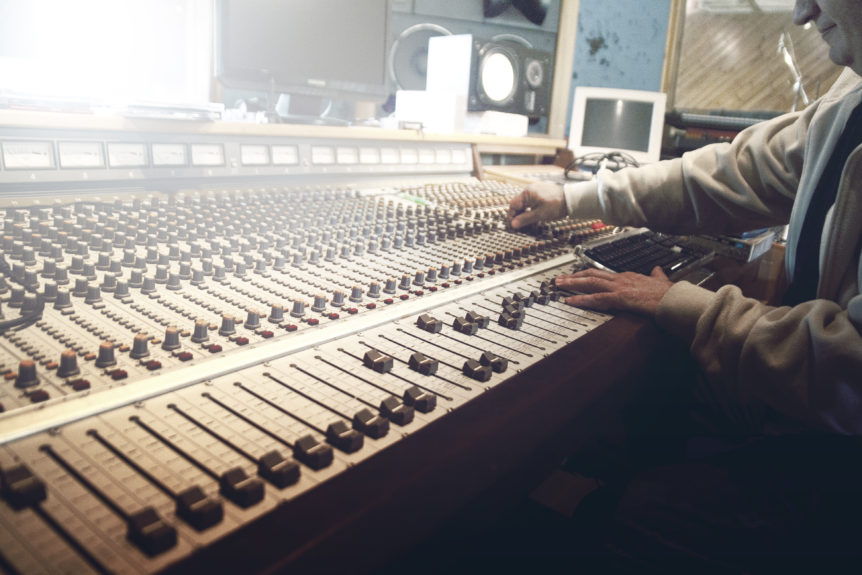 In the modern day, breaking into the music industry has progressively become a feat achievable at home for music producers. A lot of today’s biggest names simply crept out from their tiny little bedroom studios… With no more than a simple computer, software and a mic or two in tow. But surely, when you think about it, there must have been more to it, right? What made them stand out above the rest? What were the best ways to produce high-quality music at home?
In the modern day, breaking into the music industry has progressively become a feat achievable at home for music producers. A lot of today’s biggest names simply crept out from their tiny little bedroom studios… With no more than a simple computer, software and a mic or two in tow. But surely, when you think about it, there must have been more to it, right? What made them stand out above the rest? What were the best ways to produce high-quality music at home?
Technology has created a massive turnaround when you consider the way things used to work in order to get your way into the industry. The days of hoping some heavyweight producer would take notice, are kind of reaching a demise of sorts. Home music production is leaving an irrefutable mark on the music world. For this reason, this article explores the ideal ways to achieve industry worthy music in your home music studio.
Sure, it will never be a simple walk in the park to be next mega idol, but having a professional sound will always be a great place to start. Today we take a look at 13 Sure-Fire Ways to Produce High-Quality Music at Home.
How to Produce High-Quality Music at Home:
1. Having the Fundamental Gear
This may seem like an obvious place to start, but it is beyond worth the mention in our discussion. A lot of the time, especially if you’re new to the field, a common concern is, of course, the gear. And not only the gear, but also the cost. Putting together all the bits and pieces for your home music studio doesn’t always come cheap…
While it is true that you don’t need all the priciest gear out there by a long shot, or even all the gear it’s often claimed you need for that matter, a little more investment can do you a lot of good. If it is within your means, of course. The very basic requirements in terms of studio gear for recording at home include:
-
-
Audio Interface:
an interface works as an intermediary device between all input/output devices and your computer. For instance, microphone and instrument inputs, as well as headphones/monitor speaker outputs.
-
-
-
DAW Software:
A Digital Audio Workstation is a software used for mixing, recording and overall production.
-
-
-
Microphone/s:
A given, meant for the recording of all instrumentals and vocals. Microphones come in different types depending on the purpose. (Check out this article on selecting different types of microphones to suit you).
-
-
-
Pop filters:
A handy little tool used to filter out plosive “P” and “B” and sounds when recording with a microphone. These basically provide crisp clear vocal clarity for professional sounding vocals.
-
-
-
Studio Monitors:
Used during your mixing/monitoring/mastering process. Studio monitors, as opposed to ordinary hi-fi speakers, produces a flat and accurate sound. This allows the listener to fine-tune the intricate details of the recordings or the mix.
-
-
-
Headphones:
these are necessary for any studio. Headphones are used during the recording process as well as during the mixing process. Many newbie producers try to use headphones in the place of studio monitors. While it is doable, perhaps consider both in conjunction, as monitors often provide better accuracy for mixing.
-
In addition to the above key items, you may consider other elements for your home studio depending on your needs. Items such as the instruments of your choice and other technical gear would depend on what it is your aiming to achieve and what your style is.
For good recommendations/reviews on essentials studio gear for your home music studio, have a look at the recommended gear page.
2. Treat Your Recording/Listening Environment
We won’t delve too deeply into the topics of room acoustics soundproofing in this article, but these are definitely necessary elements to consider within all music studios.
Acoustics
Treating the acoustics of your studio overall makes for the better clarity and sound quality when recording with a mic. Acoustic treatment basically eliminates excess sound reflections or resonances that can impact not only the quality of the recorded sound, but also the perception of the listener while mixing.

 Soundproofing
Soundproofing
Soundproofing, simply put, eliminates the impact of external sounds that may infiltrate your studio and be picked up by microphones. Conversely, it also prevents whatever noises that occur in your studio from escaping into the external environment.
If you’d like to know all about acoustic treatment and soundproofing in detail, check out these articles:
- How to Setup Acoustic Treatment in Your Home Studio
- Soundproofing Your Home Music Studio on a Budget
3. Set Up a Studio Production Plan
We all know a good variety of tasks often take place in professional music studios. And no doubt, this will be the case in your studio at home. Studio time would involve aspects such as:
- Composing
- Rehearsing
- Recording
- Mixing
- Mastering
Don’t Overlap Tasks
It is absolutely important to avoid overlapping these tasks in a studio. Don’t compose or make changes while recording. And definitely, avoid mixing while recording or vice versa. In order to produce high-quality music at home, you want to dedicate a decent amount of time to each of these activities individually. Basically, this would allow for a more focused studio process, in which each of these elements can be fine-tuned to a tee.
Items to Prepare
Your production plan would pretty much outline a timeline for everything, assisting with overall productivity in your music studio. Also, consider preparing aspects such as tabs or sheet music for instruments, chord charts with lyrics as well as lyric sheets. Having all of this done before recording makes for a smoother, professional recording process overall.
4. The Recording Process
Depending on the music you are intending to produce, the intricacy of your recording process may vary significantly. You may simply be recording vocals and producing everything else digitally, or you may be introducing instruments as well.
There are a variety of components to this process that need to be considered to produce high-quality music at home. For instance, the setup of your microphones in relation to what you will be recording. Also, the setup of your equipment overall. We will be looking at these aspects in more detail in the steps that follow.
Another aspect worth considering prior to your recording sessions is a rehearsal session. To produce high-quality music at home, it is best for all musicians to be well prepared for a professional outcome.
5. Consider the Impact of File Sizes
Record at 24-bit
In order to capture the finer, more intricate details, opting for a higher bit-depth is the way to go. It also offers the benefit of obtaining a much greater dynamic range in your recordings. The one notable downside of the using 24-bit, as opposed to 16-bit, is the increased (1.5x) file size. Regardless, the pros here outweigh the cons.
Sample Rates
The standard sample rate in audio recording is at 44.1kHz or 48kHz. Despite this, newer audio interfaces offer rates up to 96kHz and 192kHz. And as a result, experimenting with higher sample rates is an aspect that many producers dabble with. Bear in mind, however, that the standard is what it is for a reason…
Basically, a 24-bit track recorded at 96kHz would be considerably larger in file size and occupy more space. We’re talking 3x the size. So for intricate multitrack-recording, this is definitely no the route to take. However, by all means, consider higher sample rates for simpler recordings.
Overall, just ensure that your computer has enough RAM and disk-space as far as the hard drive is concerned.
6. Mic Positioning

Consider you mic positioning
Often musicians and producers record vocals and/or instrumentals in their studios. The position of your microphones has a pretty significant impact on the sound that is recorded ultimately. You want to consider the different setups of your microphones in this regard.
Guitars
Guitars could typically be recorded with more focus on one of two areas. Either with more focus on the string action, in which case, the mic is positioned in front of the guitar between the body and neck. Alternatively, to capture the guitar’s overall characteristic resonance, you may want to place the mic at a little more of a distance from the body, only this time aligning it with the sound hole. You could consider the Audio Technica AT2035 mic for this purpose.
Drums
Recording drums can involve numerous microphones for greater flexibility, if that’s what you’re after. Dynamic Microphones often work great in this regard. However, you could get away with a great overall sound with about 4 mics in total. Simply have one for the snare, the kick drum, as well a stereo pair overhead.
Vocals
The typical setup when considering ways to produce high-quality vocals at home involves a few components. Namely, pop filters, the mic itself, and any additional insulation if necessary (i.e. reflection filters). You would naturally position the mic directly ahead of the vocalist while recording. With good acoustic treatment a pop filter, you should be able to record crisp, clear sound with a professional edge.
7. Control Headphone Bleed
In a recording studio, you’d often deal with highly sensitive microphones. Especially in the case of ribbon or condenser mics. The most minute of sounds can creep their way into your recordings and really become an adversity. For this reason, you need to be choosy about the type of headphones you go for while recording quiet tracks.
The ideal way to manage this issue would be to opt for a set of closed-back back headphones. This type of headphone is fully enclosed, and specifically designed to not let any noise escape the earcup. They’re also designed to cancel external for the user.
If you’d like, check out this review of the Beyerdynamic DT770 Pro headphones. These are a popular closed-back choice amongst world-class sound engineers.
8. Create a Follow Track
When you begin with your actual recording process, it is best to create some kind of guideline for your musicians to follow. Often a drum loop that has been pre-recorded would do the job of keeping the preferred tempo. Alternatively, you could look into using a metronome to perform the same purpose.
Maintaining the same tempo throughout all your recorded instruments is important for the sake of consistency. This can particularly become an issue if you are performing multitrack recording, during which your various instrument are not recorded simultaneously. In this case, having a consistent tempo is key in order to produce high-quality music at home.
9. Record the Rhythmic Instruments/Elements First
Typically, most music tracks are structured upon a rhythmic foundation. When the rhythmic elements of the song have been properly established, such as the drum and bass, it becomes simpler to follow along with the other instruments.
This situation is much more ideal than simply using a metronome, click track or pre-recorded drum loop. It helps give the band musicians something more realistic to work with, and ultimately enhances the process of the song taking shape.
10. Introduce Harmonies and Melodies
Next, once a good rhythmic foundation has been laid down, you’re ready to move on. The harmony and melody of a track are often arguably the more identifiable components of a song. Music listeners would generally find these elements the most recognizable, which is why executing this immaculately is important.
Harmonies
After creating the rhythmic foundation, you want to enhance it by implementing a good chord progression. Depending on the style or type of song you’re producing, this would entail elements like keyboards, piano or guitar amongst others.
Melody
Thereafter, you need to introduce the melody of the song into your recording. Generally, the melody of a song would primarily take the form of the lead vocals. Alternatively, this could also simply be instrumental such as a piano or guitar lead. A combination of elements can also be done.
Once the main melody has been recorded, you would proceed to implement the supporting melodies to accompany the lead.
11. The Editing Process
Now that we’ve established a structure as far as how a typical recording process would go, let’s take a look at editing.It is very easy to become excited and slap together the various tracks you’ve recorded, so you can get on to mixing. But in truth, if you’re really considering how to produce high-quality music at home, editing requires a good amount of focus.
The editing process is the phase in which you’d correct inevitable imperfections that occurred while recording. Editing also forms the beginning phase of all your tracks coming together to form one cohesive song. Editing is typically performed using a DAW software. There is a very wide variety of options out there that offer incredible levels of versatility to help you edit professionally.
Editing would typically entail
- pitch adjustment
- adjusting components that aren’t in time
- de-cluttering: removing unnecessary elements
- The overall arrangement of tracks (sorting elements by color-coding helps)
- Comping
Remember, you don’t want to overdo it with your editing; this is to avoid creating a track that sounds choppy. If your recorded tracks were of a great enough quality to start with, editing should only be implemented on a need-to basis.
At this stage, your recorded tracks have been arranged according to desire. And preferably in a logical manner aided by creating groups and busses. To produce high-quality music at home, having groups for your tracks according to the various instruments or vocals is key. It makes everything simple to find and less confusing.
12. The Mixing Process
You’re now prepared to mix your tracks and create one cohesive song that merges well together. Mixing is also the process in which you as the producer can become create and explore different ways to make your song interesting. While this can be an explorative process, if you’d like, the key tasks to perform when mixing are:
- Adjusting Volume Faders – For dynamic consistency. Balances the loudness/softness of instruments in relation to others
- EQ – Equalization is used to get better clarity separation. EQ helps balance out multiple elements competing for the same frequency range.
- Applying Compression – in order to even out the dynamic volume ranges of your tracks. Turns down the high peaks and turns up the more subtle elements so everything can be heard clearly.
- Reverb Application – Gives more life to your tracks. After recording in a heavily acoustically treated environment, your recorded tracks may sound dry. Subtle reverb combats this by adding space.
- Panning – Add panning for a stereo effect. You’ve been mixing in mono, and if it sounds good here, it’ll be even better in stereo
- Automation and Effects – basically to allow you to adjust very particular settings in different areas of the song, making it more dynamic, creative and unique.
13. The Mastering Process
Finally, we have the mastering process. If you’re really going to produce high-quality music at home that competes with the commercial out there, this is a skill you must hone.
Why Master a Song?
Producers master songs with the purpose of creating a truly polished final outcome. Mastering is essential, also, for creating consistency across all tracks in an album. Individual tracks can easily sound disjointed from next in the absence of mastering. Mastering ultimately ensures that you do, indeed produce high-quality music at home.
The Procedure
Mastering is very often confused with mixing. While they do share very similar techniques, mixing refers to a multitrack-recording, whereas mastering refers to a single stereo mixdown. Mastering entails:
- Audio Restoration
- Stereo Widening – dealing with the left/right balance of the mix. Making it sound bigger.
- Equalization
- Compression
- Loudness – Adding an audio limiter for appropriate loudness, a ceiling for peaks
- Bit-depth reduction & Sample Rate Conversion
- Sequencing and Spacing
There you Have it!
We’ve discussed the best-known elements to consider in order to produce high-quality music at home. Bear in mind, everything also takes time and practice to truly lead to perfection in your home music productions.

